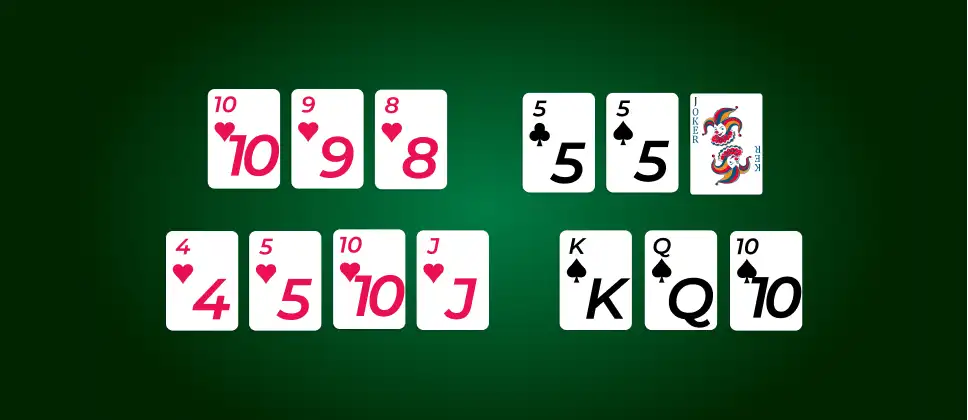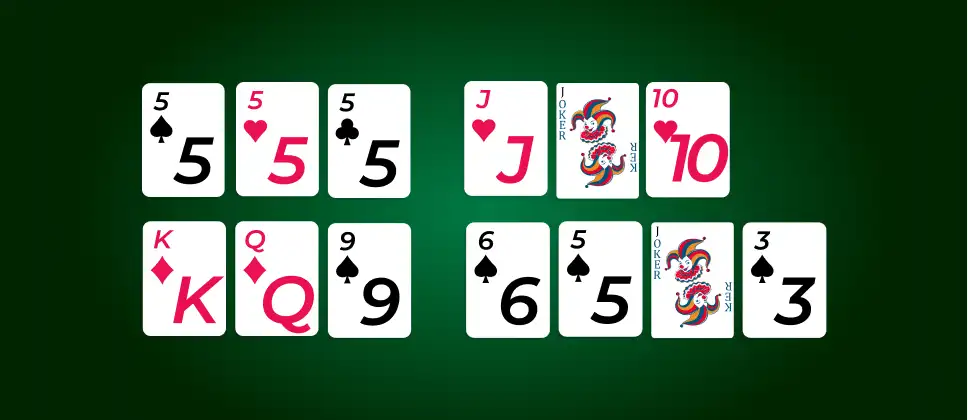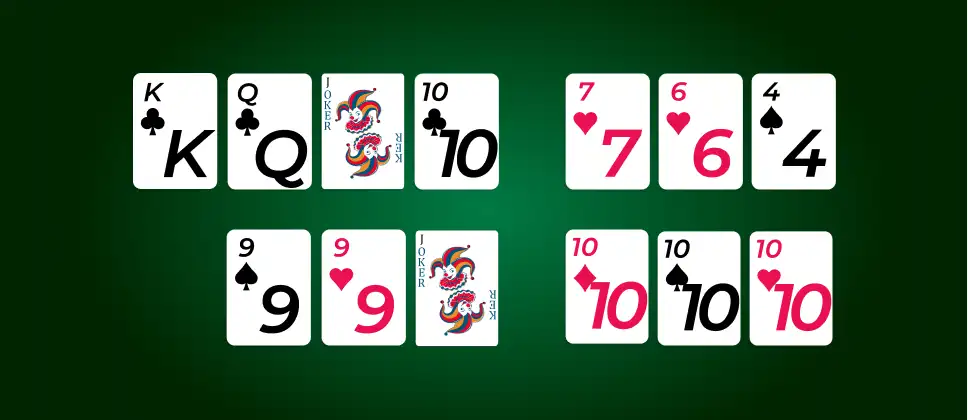
Indian Rummy is a popular rummy card game that includes points rummy, pool rummy, and deals rummy variants. This game of skill is all about melding cards into sequences and sets. Your goal is to arrange your cards into sequences and sets without any leftover cards, aiming for zero points to win.
In other words, Rummy is a group of games related to the feature of matching cards of the same rank or sequence and the same suit. The basic goal of rummy is to build melds which can be either sets (three or four of a kind of the same rank) or run.
Amongst the many rules of rummy, rummy sequence rules are important when learning how to play rummy. The ability to quickly create sequences also determines your success rate in the game. You must make a minimum of two sequences - pure sequence and impure sequence. You start by making a pure sequence, which is the most important part of your win. Without it, you can't make a valid declaration.
Below are the rummy sequence rules listed as well. Don't miss out!
What is a Rummy Sequence?
The rummy game is all about melding cards into sequences and sets. The objective of rummy is to make valid sets and sequences, using all 13 cards and declaring the game with zero points.
A rummy card sequence is the most important combination in the rummy card game. It is a group of three or more cards of the same suit arranged in consecutive order. There are two kinds of sequences - pure and impure. We will talk about these two in detail below. These sequences are essential for your playing strategy in the rummy series.
What are the sets in rummy? Three or more cards of the same rank but different suits are collectively called a set in rummy.
Types of Sequence in Rummy
In the Indian Rummy series, there are two types of sequences - Pure Sequence and Impure Sequence. Here's how you can create different rummy order of cards when playing a rummy cash game.
Pure Sequence in Rummy
A pure sequence in a rummy card game is a group of three or more cards of the same suit. This implies that the cards of the same suit have to be placed in consecutive rummy order regarding card rank. You cannot use a printed or wild joker card to make a pure sequence. However, a wild card can only be used in its original value rather than as a substitute for a missing card.
As per rummy rules, there is no valid declaration without a pure sequence. If you declare your rummy game without a pure sequence, it will be considered an invalid declaration and lead to a penalty of 80 points. Therefore, the best approach to starting the 13 card rummy card game is by forming one pure sequence and then using the remaining rummy order of cards to form any other rummy card sequence or set.
Examples of a Pure Sequence:
5♠ 6♠ 7♠ 8♠ (A pure sequence in rummy with four cards of Spades placed in consecutive rummy order)
K♦ Q♦ J♦ (A pure sequence with three cards of Diamonds placed in consecutive rummy order)
2♥ 3♥ 4♥ (A rummy sequence with three cards of Hearts placed in consecutive rummy order)
Pure Sequence with Joker
As per the Indian Rummy rules, a pure sequence is made with three or more cards of the same suit placed consecutively. A joker in rummy can create a pure sequence only in the following situation - the wild joker can be used in its original value and must belong to the same suit as other cards in that pure sequence.
Example of a pure sequence with a joker card:
Suppose you have the following cards: 10♣️, 9♣️, and 7♣️, and you need 8♣️ to make a pure sequence. However, 8♣️ is also the wild joker in the game. You can use the wild joker 8♣️, completing the sequence: 10♣️ 9♣️ 8♣️ 7♣️, as 8♣️ being the wild joker is in its original value.
Pure Sequence without Joker
According to the rummy rules, a pure sequence in the rummy card game doesn't involve a joker unless in a situation like the above. A Joker card cannot be used as a replacement for any card to make a pure sequence.
Example of a pure sequence without a joker card:
Let's say you have the cards 5♠️, 6♠️, and 7♠️. This forms a pure sequence without any need for a joker since the cards are consecutive and of the same suit. So, 5♠️ 6♠️ 7♠️ is a pure sequence without involving any jokers.
Impure Sequence in Rummy
A sequence formed by grouping three or more cards of the same suit, including a joker card, is an impure sequence. An impure sequence in the rummy card game can be made using both printed Joker and Wild Joker cards.
Examples of Impure Sequences:
5♣ 6♣ Joker 8♣ (An impure sequence with four cards of Clubs, including a joker, placed in consecutive order)
10♠ Joker 9♠ 8♠ (An impure sequence with three cards of Spades and a joker, placed in consecutive order)
Joker 7♦ 8♦ 9♦ (An impure sequence with three cards of Diamonds and a joker, placed in consecutive order)
In Rummy, impure sequences with jokers infuse excitement and strategy. These sequences of three or more cards of the same suit, allow flexibility in gameplay. Incorporating jokers adds unpredictability, requiring players to adapt their rummy strategies dynamically.
Rummy Sequence Rules
According to the rummy game rules, the players must make at least two valid sequences in rummy to make a valid declaration. The two rummy sequences must include at least one pure sequence.
The players must group at least three cards to create a sequence or set in the online rummy game.
Sequences can go in ascending (e.g., 3-4-5) or descending (e.g., K-Q-J) order.
Sets are groups of cards with the same rank but different suits.
Sequences must be pure or impure. Pure sequences have no wild or printed Joker cards, while impure sequences can use Joker cards.
Jokers can be used to replace any missing card in an impure sequence.
You typically need at least one pure sequence to win a rummy game.
After the mandatory requirement of at least two sequences, players can create pure or impure sequences or sets with the remaining cards in hand.
As per rummy rules, the player who makes an invalid declaration receives 80 points as a penalty.
Creating More Than One Pure Sequence in Rummy
The online rummy sequence rules mandate the creation of at least one pure sequence for a valid declaration in the rummy game. Therefore, you can create multiple pure sequences in rummy if you have the cards. In fact, if you have suitable cards, you can also use all the cards to create pure sequences in the Indian rummy game.
Examples of a valid declaration made with all pure sequences include:

1. Face Cards Sequence
You can create a sequence with King, Queen, and Jack face cards. The sequence using face cards scores 11, 12, and 13 for Jack, Queen, and King respectively.
2. Low-Point Cards Sequence
Arranging your cards from 2 to 5 in an ascending or descending order forms a sequence of low-point cards. For instance, you can form a low point card sequence with 2, 3, 4, or 3, 4, 5 of the same suit. The cards have to be from the same suit for a valid pure sequence of low-point cards.
3. High-Point Cards Sequence
Arranging your cards from 6 to 10 in combination with face cards forms a high-point card sequence. For instance, you can form a high point cards sequence with 8-9-10, or 9-10-J-Q, or 10-J-Q from the same suit.
Valid declaration in rummy
A valid declaration in rummy is made when there are at least two sequences, including one pure sequence, and the remaining cards are grouped into either sequences or sets. Here's how you can make a valid declaration:
When 13 cards are dealt, you use the Sort button to arrange your cards in groups such as below.

In the above hand, after sorting the cards, you can see a pre-made pure sequence (10♥️ 9♥️ 8♥️) and a pre-made set (5♣️ 5♠️ Joker). The remaining cards must be arranged according to rummy sequence rules to make a valid declaration. Since there is only one pure sequence, you need to make at least one more sequence (pure or impure), and the remaining cards can be arranged in a sequence or set, depending on the cards you draw.
Here's an example of how you can make a valid declaration in a rummy game:
Turn 1
During your first turn, assuming you draw a J♠️. You can combine this card in the last group of (K♠️ Q♠️ 10♠️) and create another pure sequence (K♠️ Q♠️ J♠️ 10♠️). To discard a card, you can choose to get rid of the highest card J♥️ from the group (4♥️ 5♥️ 10♥️ J♥️).
After your first turn, your hand will consist of the below groups.
(10♥️ 9♥️ 8♥️), (5♣️ 5♠️ Joker), (4♥️ 5♥️ 10♥️), and (K♠️ Q♠️ J♠️10♠️)
Turn 2
During your next turn, suppose you draw a printed joker, you can use that card to add to the (4♥️ 5♥️ 10♥️) group. Add the printed joker and discard 10♥️ to complete an impure sequence (4♥️ 5♥️ PJ).
After this turn your hand will consist of the below groups:
(10♥️ 9♥️ 8♥️), (5♣️ 5♠️ Joker), (4♥️ 5♥️ PJ), and (K♠️ Q♠️ J♠️10♠️)
Since you have two pure sequences, one impure sequence, and one set, you can now go ahead and make a valid declaration with a zero score as there is no ungrouped card.
If you declare your game before any other player, you will be the winner of the game.
Possible Combinations for Making a Valid Declaration
One pure sequence + One impure sequence + Two sets:
Example: 3♠ 4♠ 5♠, 6♠ 7♠ Joker, 8♣ 8♠ 8♦, Q♦ Q♣ Q♠.
One pure sequence + Two impure sequences + One set:
Example: A♦ 2♦ 3♦, 4♣ 5♣ Joker, 6♦ 6♣ 6♥, 7♠ 7♦ 7♣.
One pure sequence + Three impure sequences:
Example: 8♥ 9♥ 10♥, J♣ Joker Q♣, K♠ K♦ K♣, 2♠ 3♠ 4♠.
Two pure sequences + Two sets:
Example: 5♣ 6♣ 7♣, 8♠ 9♠ 10♠, J♦ J♣ J♠, Q♣ Q♠ Q♥.
Two pure sequences + Two impure sequences:
Example: 3♣ 4♣ 5♣, 6♦ 7♦ Joker, 8♥ 8♦ 8♠, 9♠ 10♠ J♠.
Two pure sequences:
Example: A♠ 2♠ 3♠, 7♦ 8♦ 9♦.
Three pure sequences + One set:
Example: 10♣ J♣ Q♣, 2♥ 2♠ 2♦, 4♠ 5♠ 6♠, K♦ K♠ K♣.
Three pure sequences + One impure sequence:
Example: 6♦ 7♦ 8♦, 9♣ 10♣ Joker, J♦ Q♦ K♦, 3♠ 3♣ 3♥.
Three pure sequences:
Example: 4♣ 5♣ 6♣, 7♥ 8♥ 9♥, J♠ Q♠ K♠.
Four pure sequences:
Example: A♥ 2♥ 3♥, 4♦ 5♦ 6♦, 7♠ 8♠ 9♠, 10♣ J♣ Q♣.
Invalid declaration
The rummy rules state that a player must make at least two sequences, including one pure sequence, to make a valid declaration. If the player fails to make two sequences, including the mandatory pure sequence, it will be an invalid declaration.
Here are a few examples of an invalid declaration in the rummy card game:
Example 1:

In the above example, we can see one set (5♠️ 5♥️ 5♣️)and three impure sequences (J♥️ PJ 10♥️), (K♦️Q♦️9♣️), and (6♠️ 5♠️ Joker 3♠️). Since there is no pure sequence, this will be an invalid declaration.
Example 2:

In the above example, we can see one pure sequence (8♥️ 9♥️ 10♥️ J♥️) and three sets (5♠️ 5♦️ 5♣️), (10♦️ 10♣️ Joker), and (8❤️ 8♠️ 6♣️). Since there is only one sequence (two sequences mandatory for a valid declaration), this will be an invalid declaration, according to the rummy rules.
Example 3:

In the above example, there are two impure sequences (K♣️ Q♣️ Joker 10♣️) and (7♥️ 6♥️ 4♠️), and two sets (9♠️ 9♥️ Joker) and (10♦️ 10♠️ 10♥️). Since there is no pure sequence, this will be an invalid sequence.
FAQs
Is making a rummy sequence skill or luck?
Making a rummy sequence is more of skill than luck. It requires strategy and skill to arrange cards in order. While luck may play a role in getting favorable cards, winning depends largely on planning and decision-making. Players draw and discard cards strategically to make sequences, making it a game of skill.
What is the difference between sequences and sets in rummy?
In rummy, a set comprises cards of the same rank but different suits, like 7♠ 7♦ 7♣. Conversely, a sequence consists of consecutive cards of the same suit, such as 3♠ 4♠ 5♠.
Can we have Ace, King, Queen, and Jack in a sequence in Rummy?
No, Ace, King, Queen, and Jack cannot form a sequence in rummy, as sequences must follow consecutive order.
What is the diamond sequence in Rummy?
A diamond sequence in rummy pertains to a sequence of cards exclusively from the diamond suit, like 2♦ 3♦ 4♦.
What is the best sequence in the cards?
The best sequence in rummy is a pure sequence, which necessitates consecutive cards of the same suit without any Jokers.
How do I form a pure sequence in rummy?
To create a pure sequence in rummy, one must arrange at least three or more cards of the same suit without any Jokers. For instance, 4♠ 5♠ 6♠ forms a pure sequence.
Disclaimer
